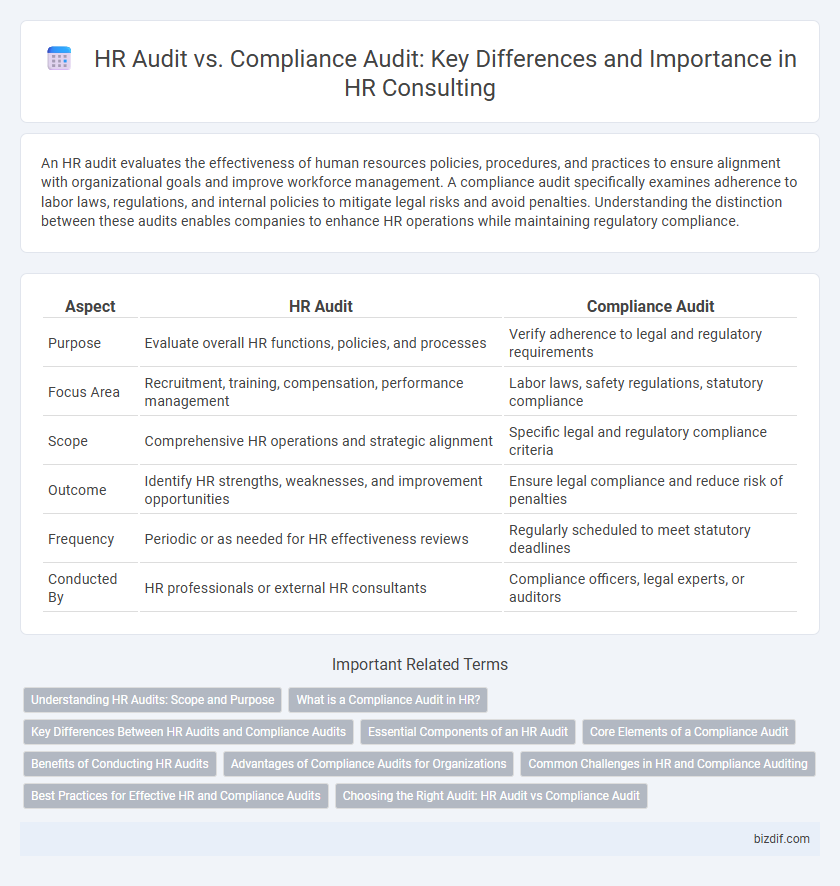An HR audit evaluates the effectiveness of human resources policies, procedures, and practices to ensure alignment with organizational goals and improve workforce management. A compliance audit specifically examines adherence to labor laws, regulations, and internal policies to mitigate legal risks and avoid penalties. Understanding the distinction between these audits enables companies to enhance HR operations while maintaining regulatory compliance.
Table of Comparison
| Aspect | HR Audit | Compliance Audit |
|---|---|---|
| Purpose | Evaluate overall HR functions, policies, and processes | Verify adherence to legal and regulatory requirements |
| Focus Area | Recruitment, training, compensation, performance management | Labor laws, safety regulations, statutory compliance |
| Scope | Comprehensive HR operations and strategic alignment | Specific legal and regulatory compliance criteria |
| Outcome | Identify HR strengths, weaknesses, and improvement opportunities | Ensure legal compliance and reduce risk of penalties |
| Frequency | Periodic or as needed for HR effectiveness reviews | Regularly scheduled to meet statutory deadlines |
| Conducted By | HR professionals or external HR consultants | Compliance officers, legal experts, or auditors |
Understanding HR Audits: Scope and Purpose
HR audits evaluate human resource policies, practices, and procedures to ensure alignment with organizational goals and identify areas for improvement. They encompass workforce planning, talent management, employee engagement, and performance evaluation to enhance overall HR effectiveness. Compliance audits strictly assess adherence to legal regulations and labor laws, focusing on minimizing risks and avoiding penalties related to employment standards.
What is a Compliance Audit in HR?
A Compliance Audit in HR systematically reviews an organization's adherence to labor laws, employment standards, and internal policies to mitigate legal risks. It evaluates areas such as wage and hour laws, workplace safety regulations, anti-discrimination policies, and record-keeping practices to ensure regulatory conformity. This audit helps organizations identify non-compliance issues, reduce penalties, and maintain effective human resource governance.
Key Differences Between HR Audits and Compliance Audits
HR audits evaluate overall HR functions including recruitment, performance management, and employee development, aiming to improve organizational effectiveness and align HR practices with business goals. Compliance audits specifically assess adherence to labor laws, regulations, and internal policies to mitigate legal risks and ensure regulatory compliance. Key differences lie in scope and purpose: HR audits focus on strategic HR improvements, while compliance audits emphasize regulatory conformity and risk management.
Essential Components of an HR Audit
An HR Audit systematically evaluates policies, procedures, and practices related to workforce management, including recruitment, training, performance appraisal, and employee relations, ensuring alignment with organizational goals. Key components encompass compliance with labor laws, assessment of HR metrics such as turnover rates and absenteeism, and scrutiny of compensation and benefits administration. This contrasts with a Compliance Audit, which primarily focuses on adherence to regulatory requirements and legal standards without the broader strategic review found in an HR Audit.
Core Elements of a Compliance Audit
A Compliance Audit in HR focuses on verifying adherence to labor laws, employment regulations, and company policies to mitigate legal risks. Core elements include reviewing payroll records, employee classifications, workplace safety protocols, and documentation of equal employment opportunity practices. This audit ensures that organizations maintain regulatory compliance, thereby avoiding penalties and fostering a fair workplace environment.
Benefits of Conducting HR Audits
Conducting HR audits enhances organizational efficiency by identifying gaps in human resource policies, practices, and employee relations, ensuring alignment with business objectives. HR audits help mitigate legal risks by proactively detecting non-compliance issues related to labor laws, workplace safety, and diversity regulations. Improved employee engagement and retention result from transparent communication and consistent application of HR standards uncovered during the audit process.
Advantages of Compliance Audits for Organizations
Compliance audits provide organizations with a clear assessment of adherence to legal and regulatory requirements, minimizing the risk of fines and legal penalties. These audits enhance corporate governance by identifying gaps in policies and ensuring consistent application of industry standards. Improved risk management and increased stakeholder confidence are key benefits, fostering a proactive approach to regulatory compliance.
Common Challenges in HR and Compliance Auditing
HR audits often face challenges such as incomplete documentation, inconsistent policy enforcement, and outdated employee records, which can compromise the accuracy of the audit results. Compliance audits encounter difficulties in interpreting evolving labor laws, ensuring adherence to regulatory requirements, and managing data privacy concerns. Both HR and compliance audits require thorough understanding of organizational processes and legal frameworks to effectively identify risks and implement corrective actions.
Best Practices for Effective HR and Compliance Audits
Effective HR and compliance audits require a comprehensive evaluation of organizational policies, ensuring alignment with labor laws and internal standards. Best practices involve detailed documentation review, employee interviews, and risk assessment to identify gaps and enhance accountability. Leveraging technology for data analytics and maintaining continuous monitoring improves accuracy and drives proactive compliance management.
Choosing the Right Audit: HR Audit vs Compliance Audit
Selecting the right audit between HR Audit and Compliance Audit depends on your organization's priorities; HR Audits evaluate overall human resource policies, practices, and effectiveness, while Compliance Audits focus strictly on adherence to labor laws and regulatory requirements. HR Audits identify gaps in talent management, employee engagement, and organizational culture, providing strategic recommendations for improvement. In contrast, Compliance Audits minimize legal risks by ensuring that employee records, contracts, and workplace conditions meet government standards and industry regulations.
HR Audit vs Compliance Audit Infographic

 bizdif.com
bizdif.com